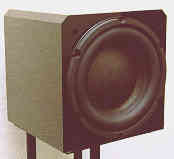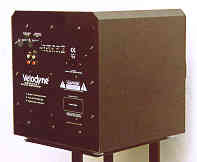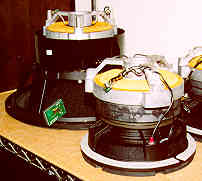Product Review - Velodyne HGS-10 Powered
Subwoofer - December, 1997
J.E. Johnson, Jr.
![]()
 |
Velodyne HGS-10 Powered Subwoofer 10" Driver -Sealed Box, Servo-Feedback Manufacturer's FR Specs: 20 Hz - 125 Hz � 3 dB Built-in Amplifier: 1,000 watts rms Size: 11" H x 11" W x 11" D Weight: 36 pounds Price: $1,595 USA (Black gloss finish)
|
| Velodyne Acoustics, Inc., 1070 Commercial Street, Suite 101, San Jose, California 95112; Phone 408- 436-7270; Fax 408-436-7276; Web http://www.velodyne.com E-Mail [email protected]. |
Since the introduction of small, highly powered subwoofers a year or so ago, Velodyne has been working on a product to become competitive in this new market. The HGS-10 (HGS stands for High Gain Servo) is the result. It has a 10" driver, which uses the same magnet (19.3 pounds for the magnet structure) and voice coil (3" push-pull) assembly as the 18" driver in their FSR-18 (but without the bucking magnet), and is powered by a newly designed switching amplifier (140 kHz switching frequency at the output stage), rated at 1,000 watts rms into 6 Ohms. The driver has the same high excursion (2" max) of the FSR-18. Servo-feedback technology is utilized (solid state motion detector mounted near the voice coil). With 6,000 �f total capacitance, and � 160 V rms DC on the power supply capacitors, there are 76.8 Joules of energy storage in the HGS-10 conventional design power supply (the switching is in the output stage). The driver and amplifier barely fit in the 11" cube. On the back are an ungrounded AC socket, RCA line-level inputs and high-pass (80 Hz, 6 dB/octave) outputs, Volume control, Low-Pass crossover control (40 Hz - 120 Hz, 12 dB/octave initially, 48 dB/octave ultimately), Crossover in/out switch, Phase toggle (00 or 1800), Subsonic selection (20 Hz or 35 Hz), and a remote sensor switch. The enclosure is nicely finished in gloss black polymer veneer. The photo below, left, shows the HGS-10 driver next to an FSR-18 driver.


For testing (listening and measurments), we placed the HGS-10 in a corner, with the driver pointing out into the room (25' x 30'). The floor near the speakers is hardwood, with no rug. We used the HGS-10 to supplement our Monitor Audio Studio 20 SE Floorstanding speakers, driven by an Audio Electronic AE-1 Tube Preamplifier, White Audio B-80 Monoblock Power Amplifiers, and Nordost SPM Reference Interconnects and Speaker Cables. Source was the Audio Alchemy CD Package, including Digital Interface.
For music, one of my favorite tests is the opening track ("The Very Thought of You") of Natalie Cole's "Unforgettable" (Elektra; 9-61049-2). We use this disc for all types of speakers, but for subwoofers, there is a series of bass notes that are perfect for testing depth and accuracy. The HGS-10 did beautifully, and the notes were clean and powerful but not overpowering (they would be overpoweringly boomy if there were significant harmonic distortion). There was no chestiness in her voice either, illustrating the steep curve in the crossover. The Studio 20 SEs do well into modestly deep bass, so we found that setting the HGS-10 low-pass to about 40 Hz worked well. Equally, the HGS-10 reproduced the pedal notes on the Jean Guillou organ transcription of Mussorgsky's "Pictures at an Exhibition" (Dorian; DOR-90117). However, this raises a couple of issues. (1) What is a subwoofer? For any particular set of speakers, the woofers will respond down to certain point. The subwoofer is for the frequencies below that point. So, if you use bookshelf speakers with a response to 70 Hz, the subwoofer is for the frequencies below 70 Hz. If your speakers are floorstanders that respond to 40 Hz, the subwoofer is for the frequencies below 40 Hz. (2) What is the function of the HGS-10 and others like it? These new designs with long throw drivers and powerful amplifier in a small box are not supposed to replace the big 15" - 18" subwoofers. In spite of their astonishing abilities, they simply cannot move air like a big driver with a long throw, a powerful amplifier, in a big box. But, they are perfect for apartments, dormatories, or for situations where a big subwoofer enclosure is not compatible with the other furniture. There are some sub-20 Hz tones in the Gillou transcription that the HGS-10 will not compare with what the Velodyne FSR-18 can do. So, we should not look at this new technology as something that will supplant all the big subwoofers, but as a completely separate type of product that works beautifully for certain environments. In our home theater lab, the HGS-10 was incredible. Starcruiser engine sounds are something that really add impact, such as the opening sequence of "Return of the Jedi" on LD in Pro Logic. You don't need DD or DTS to appreciate potent bass. I put the HGS-10 behind our 19" table-top TV in the kitchen, and connected it to the line-level audio outputs. You should have seen the look of surprise on some dinner guests' faces when we watched Star Trek, while enjoying pasta Alfredo. The engine room sounds were coming from everywhere. They looked at the ceiling, under the dinner table, all around, and then I slid the TV out of the way for them to see the HGS-10. The point is, this thing will fit anywhere and do a great job.
| Room Response - Velodyne HGS-10 Subwoofer -- Grille off -- Set to 90 dB at 25 Hz -- (This is not maximum output, but rather just the response in an "average" room with the volume set to 90 dB at 25 Hz.) |
| 1 meter | 13 feet |
| 10 Hz | 70.4 dB | 10 Hz | 73.5 dB |
| 12.5 Hz | 80.1 dB | 12.5 Hz | 83.3 dB |
| 16 Hz | 83.8 dB | 16 Hz | 86.3 dB |
| 20 Hz | 82.8 dB | 20 Hz | 90.0 dB |
| 25 Hz | 90.7 dB | 25 Hz | 90.5 dB |
| 31.5 Hz | 95.7 dB | 31.5 Hz | 87.3 dB |
| 40 Hz | 89.3 dB | 40 Hz | 94.1 dB |
| 50 Hz | 90.5 dB | 50 Hz | 83.9 dB |
| 63 Hz | 95.5 dB | 63 Hz | 95.7 dB |
| 80 Hz | 94.7 dB | 80 Hz | 85.2 dB |
| 100 Hz | 91.1 dB | 100 Hz | 87.0 dB |
| 125 Hz | 81.7 dB | 125 Hz | 81.0 dB |
| 160 Hz | 73.5 dB | 160 Hz | 70.0 dB |
The room response is quite flat down to about 25 Hz in the near field, and down to 20 Hz in the far field test. We obtained 104.5 dB at 25 Hz (near field) before amplifier clipping set in.
THE INEVITABLE COMPARISON: Click here.
To summarize, the Velodyne HGS-10 is the latest member of a very fine subwoofer family from venerable Velodyne Acoustics. Incorporating proven servo-feedback technology and a new amplifier design, this subwoofer shows how much thunder can come from such a small container. If your audio room or home theater is not large enough to hold one of the HGS-10's bigger brothers, or if you just think that hiding the source of your crash, wham, boom is cool, check this product out.
John E. Johnson, Jr.
![]()
� Copyright 1997 Secrets of Home Theater & High Fidelity
Return to Table of Contents for this Issue.

